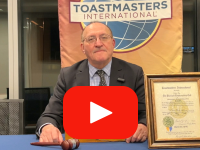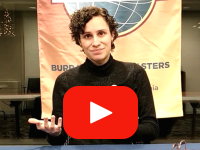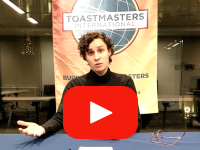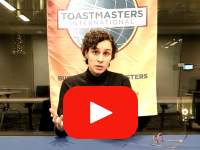|
|
| |
| Greeter |
|
This role is applicable to in-person meetings only. As Greeter, your duties are to arrive 10-15 mins before the meeting starts and greet members and guests as they arrive.
Be in the lobby or outside the meeting room and, as people arrive, greet them and welcome them to the club.
|
| |
| If the person is a guest: |
| - |
write down their name and contact info on the guest sign-up sheet |
| - |
give them a name tag |
| - |
escort them to the meeting room before the meeting begins |
|
| |
| At the start of the meeting, you will be asked to introduce the guests.
The Greeter is an extremely important role if we have a lot of guests.
You are probably one of the first people guests will talk to and how they are treated in the first 60 seconds may
determine if they visit us again or not. If you find you are having trouble looking after guests because there are
so many of them, do not hesitate to ask a few members to help out.
|
| |
Video Tutorial
|

|
| |
| back to top |
| |
| Sergeant at Arms |
The Sergeant At Arms is an Executive position and this person will fulfill this role most meetings.
If they are away, any member may be asked to fill in.
The jobs of the Sergeant At Arms can be divided into three sections, depending on where we are in the meeting.
|
| |
| Before the meeting (for in-person meetings only): |
| - |
prepare the room for the meeting (ask other members to help) |
| |
- place extra chairs along the walls |
| |
- put out glasses of water |
| |
- hang up the club banner |
| |
- set up the timing device |
| |
- put out the award ribbons, Guestbook, brochures |
| |
- hand out speech evaluation forms |
| - |
ask speakers in the second half if they need to use the lecturn |
| - |
reserve your seat near the lecturn |
| - |
close all doors right before the meeting |
| |
| During the meeting: |
| For in-person meetings |
| - |
start the meeting by welcoming everyone |
| - |
ask people to turn off their cell phones |
| - |
hand control to the Chair |
| - |
manage the use of the lecturn; make sure it is removed during Table Topics and put back in place for Table Topics evaluations |
| - |
open the second half of the meeting |
| For virtual meetings |
| - |
start the meeting by welcoming everyone |
| - |
ask people to turn on their cameras and turn off their microphones |
| - |
hand control to the Chair |
| - |
open the second half of the meeting |
| |
| After the meeting (for in-person meetings only): |
| - |
clean up the room, put materials back into the supply box |
| - |
put away the glasses |
| |
Video Tutorial
|

How to call meeting to order |

How to be Sergeant-at-Arms |
|
|
| |
| back to top |
| |
| Invocation |
|
The Invocation is a short speech that is supposed to inspire or motivate the audience. Since it is given at the
start of the meeting, it helps set a positive tone for the rest of the meeting. There are several approaches to
doing this role.
|
| |
| 1. |
Tell a story. If there is a story you know (either real or fictional) that is inspiring, then this would make a good Invocation.
|
| |
| 2. |
Start with a quote and create an invocation around it. |
| |
| 3. |
Tell us something you have learned recently and how it relates to the members. |
|
| |
Video Tutorial
|

|
| |
| back to top |
| |
| Wit |
| The role of the Wit is to add humor to the meeting and
loosen the members up before we tackle Table Topics. Pick a joke that is funny and clean. We are a
business-oriented club after all. |
| |
Video Tutorial
|

|
| |
| back to top |
| |
| Timer |
The Timer will time speeches so that speakers do not go
over their allotted times.
When introducing the role, you should start by providing a general comment about the importance of time
and why we do it in Toastmasters. Then, tell the audience the timing rules. There are two sets of rules -
Table Topics and everything else.
For Table Topics, speakers can speak for up to 2 minutes. When there is 1 minute left, the green light will go on.
When there are 30 seconds left, the yellow light will go on and the speaker should begin to conclude the speech.
When their time is up, the red light goes on. If they go 15 seconds over, they will hear 1 buzz. If they go 30 seconds
over, they will hear 2 buzzes and then they will be clapped down.
For the other speeches, when there are 2 minutes left in the speech, the green light goes on. When there is 1 minute
left, the yellow light goes on and when time is up, the red light goes on. Speakers will be buzzed once if they go
15 seconds over and twice if they go 30 seconds over.
The other speeches that you will need to time are prepared speeches and all evaluations. You do not need to
time the Wit, Invocation, and Introductions. For Table Topics, prepared speeches, and speech evaluations, write down the speakers' times.
You will be asked to present the times during the meeting.
One important thing to remember is members doing their Ice Breakers will be timed but not buzzed.
For in-person meetings, the Timer will use the timing device which has the green, yellow, and red
lights as well as the buzzer.
For virtual meetings, you can use these backgrounds: Green
Yellow
Red (Right-click and select 'Save Link As' to save images)
|
| |
Video Tutorial
|

|
| |
| back to top |
| |
| Introductions (Table Topics Master, Toastmaster) |
This role involves introducing the Table Topics Master or
Toastmaster. You should provide some general information about the person. If you are familiar
with the person and their accomplishments in Toastmasters, you can include those in your
introduction to build the person's credibility and create excitement.
When preparing for this role, ask the person 1-2 days before the meeting some general questions
(hobbies, interests, job, etc). Next, ask them questions about their Toastmasters experience
which you can incorporate into the introduction. Some questions you can ask are:
|
| - |
how long have they been in Toastmasters |
| - |
have they achieved any designations (eg. Pathway) |
| - |
have they competed in any contests or won contests |
| - |
have they won any club awards (eg. Toastmaster of the Year) |
| - |
have they served on the club executive |
|
| |
If there is something that the speaker does
really well (eg. they have an excellent vocabulary), then include it in your introduction. If you are a
new member, you can ask an experienced member to assist you in your introduction. Over time, you will
get to know the members better and it gets easier to introduce speakers without having to ask them any
questions in advance.
Do not overpraise or upstage the speaker. Remember, they are the star, not you. Also, leave the
person's name until the end and lead the applause. |
| |
Video Tutorial
|

|
| |
| back to top |
| |
| Table Topics Master |
As Table Topics Master, you will be leading the club through
a 20 minute Table Topics session. Therefore, it is important to be prepared for this role.
As Table Topics Master, do:
|
| - |
tell us what Table Topics are and why we do them |
| - |
inform us how you will choose speakers (will you wait for volunteers or just simply pick speakers?) |
| - |
advise the guests they will not be picked but are encouraged to volunteer |
| - |
have 5-7 topics or questions |
| - |
choose speakers who do not have a speaking role |
| - |
have topics that anyone can answer |
| - |
lead the applause before and after a speech |
| - |
remain standing until the Table Topics speaker has spoken (for in-person meetings only) |
| - |
know what to do when control is passed between you and the Chair (eg. stand, shake Chair's hand, accept or pass gavel) (for in-person meetings only) |
|
| |
| There are some things to avoid when doing this role. Avoid controversial topics (eg. sex, politics, religion)
Do not pick on the Table Topics Evaluator to speak. Also avoid picking on
members who will be speaking in the second half unless you have run out of members. Last but not least, if
no one volunteers for a topic, just pick a member. Do not wait too long.
|
| |
Video Tutorial
|

|
| |
| back to top |
| |
| Toastmaster |
The Toastmaster leads the club through the second half of the meeting when members are delivering their prepared speeches.
Like the Table Topics Master, this is a sizable role and adequate preparation is necessary if you are going to handle
this role smoothly.
Before the meeting, find out who will be speaking in the second half and what Pathways programs, project numbers, objectives, and titles are.
Get some background information (hobbies/interests, job, education, goals, etc) on each speaker and include it in your speech
introduction. Try to do this 1-2 days before the meeting.
As Toastmaster:
|
| - |
briefly describe your role |
| - |
explain the Pathways program |
| - |
inform us each speech will be evaluated |
| - |
encourage us to provide written comments after each speech using the provided forms or online feedback form |
| - |
introduce each speaker properly (more details below) |
| - |
allow for 1 minute of silence between each speech for written comments |
| - |
call on each evaluator to evaluate their designated speaker |
| - |
lead the applause before and after a speech |
| - |
remain standing until the speaker/evaluator has spoken (for in-person meetings only) |
| - |
know what to do when control is passed between you and the Chair (eg. stand, shake Chair's hand, accept or pass gavel) (for in-person meetings only) |
|
| |
When introducing the speaker, withhold their name and speech title until the end. Tell us the Pathway program the speaker is working on,
along with the speech number and objectives. Provide us some background information on the speaker.
When you are ready to introduce the speaker, the correct procedure is to read the speech title followed by the person's name,
followed by the name again, and then the speech title again.
For example: "Please help me welcome Three Simple Rules by Doug Griffin, Doug Griffin, Three Simple Rules"
If a speaker is delivering their Ice Breaker, you do not need to provide any background information since that is the whole
purpose of the speech.
|
| |
| back to top |
| |
| Evaluation Guidelines |
Evaluation is an important part of Toastmasters - for both
the person being evaluated and the person doing the evaluation. For the person being evaluated, they will get valuable
feedback and learn how to be better next time. For the evaluator, they will learn some valuable skills - how to listen, think
critically, and deliver a speech with little preparation.
|
| Below is a list of things to look for when evaluating a speech: |
| |
| Content and Structure |
| - |
did speech have a clear structure |
| - |
introduction - did it effectively introduce the speech topic; did it create interest |
| - |
body - did it accomplish what the speaker had set out to do |
| - |
conclusion - did conclusion wrap up the speech properly; did it have impact |
| - |
were the transitions between the introduction, body, and conclusion smooth |
| - |
was the speech appropriate for the speech objectives and audience |
| - |
did the speech have a logical flow; was it easy to follow |
| - |
did the speech have appropriate examples |
| - |
did the speaker personalize the speech |
| - |
was humor used effectively |
| |
| Language |
| - |
was the language appropriate; did it enhance the speech |
| - |
did the speaker use descriptive, picturesque words |
| - |
did the speaker use ums, ahs, and filler words (ex. and, so) |
| - |
did the speech have run-on sentences |
| - |
were pauses used effectively |
| |
| Body Language |
| - |
were facial expressions appropriate (smile, frown, neutral expression) |
| - |
did the speaker stand in one place or move around; did the speaker stand confidently |
| - |
were hand gestures effective |
| - |
did the speaker establish eye contact around the room |
| |
| Other |
| - |
comment on volume, tone, speed, and vocal variety |
| - |
describe the speaker's composure - calm, confident, nervous, tense |
| - |
did the speaker engage the audience; did they hold the audience's attention |
| - |
was the speaker prepared |
| - |
did the speaker deliver the speech within the provided time |
| - |
was the speaker dressed appropriately |
| - |
if visual aids were used, comment on their use |
| - |
did the speaker have credibility or expertise on the subject matter |
| - |
describe your personal connection to the speech (did you learn anything,
how did you feel after the speech, can you relate to the speaker) |
|
| |
| When evaluating, always refer to the person being evaluated in the third person rather
than the second person. For example, instead of saying "You used good hand gestures and you had good eye contact", say "John used good
hand gestures and he had good eye contact". An evaluation is for the whole audience, not just the speaker. |
| |
| back to top |
| |
| Table Topics Evaluator |
The Table Topics Evaluator evaluates the Table Topics Master and Table Topics speakers. This can be
a challenging role because you have to evaluate a number of speakers with little time to prepare. The key to a successful evaluation
is not to provide a thorough evaluation of each speaker but to pick out 2 things the speaker did well and 1 point for improvement.
Include some examples in your evaluation.
In addition to using the Evaluation Guidelines, look for the following things:
|
| - |
did the speaker time the speech well |
| - |
how well did the speaker answer the question |
| - |
did the speaker answer the question right away or did they take their time |
| - |
did the speaker support their answer with appropriate arguments, opinions, and/or examples |
| - |
comment on the speaker's knowledge of the subject matter |
| - |
use the Sandwich technique described below to structure your evaluation |
|
| |
| At the end of your evaluation, you will present the Best Table Topic award to the best speaker. |
| |
Video Tutorial
|

|
| |
| back to top |
| |
| Speech Evaluator |
The Speech Evaluator has the important role of evaluating a prepared speech. There are
several evaluation techniques used, but the most common is the Sandwich approach.
With this technique, you will: |
| |
| Begin with encouragement |
| - |
always begin your evaluation with encouraging words for the speaker |
| - |
if the speaker accomplished the speech's objectives, point that out |
| - |
using the Evaluation Guidelines,
point out 2-3 things the speaker did well |
| |
| Provide points for improvement |
| - |
comment on what the speaker could have done to make the speech more effective |
| - |
take into account the speaker's experience level |
| |
| End on a positive note |
| - |
conclude by returning to the speaker's strengths |
| - |
save your most positive comments for last |
|
| |
Here are some additional resources you can use to help you prepare for an
evaluation:
Evaluate To Motivate
Evaluation Frames
Speech Evaluation Tips
|
| |
| back to top |
| |
| Grammarian |
The Grammarian provides the Word of the Day at the start of the meeting
and encourages members to use that word. This word should be one that we do not use on a regular basis and be positive in nature. Make
sure you put up the word, its definition, and an example of how to use it for everyone to see.
In
addition, you will carefully listen to the language being used by everyone during the meeting and provide an evaluation at the
end of the meeting.
The evaluation will include some or all of the following:
|
| - |
examples of descriptive and picturesque phrases |
| - |
incorrect grammatical uses |
| - |
suggestions for improvement in language uses |
| - |
recognition of speakers who use the Word of the Day |
|
| |
The Language Evaluation Checklist is also a good guide
to performing this role.
You can view previous Burrard Toastmasters Words of the Day here.
|
| |
| For virtual meetings, the Grammarian also performs the duty of the Ah-Counter. The combined Grammarian/Ah-Counter
role is called Language Evaluator. |
| |
Video Tutorial
|

|
| |
| back to top |
| |
| Ah-Counter |
| The purpose of Ah-Counter is to note words and sounds used as "crutch" and "pause filler" such as ah,
um, er, and, but, well, so, you know. You will signal speakers
when pause fillers are used and report on the use of these words and sounds.
|
| - |
prior to meeting, prepare a brief explanation of the duties
of the Ah-Counter for the benefit of guests and members |
| - |
upon arrival at the meeting, get a pen, ah-counter form,
and red card from resource bin |
| - |
during the meeting, use red card to signal speakers when
they use "pause fillers" such as ah, um, er. We do not use red card
to note "crutch" words such as and, but, well, so, you know.
Note use of all "pause fillers" and "crutch" words in the ah-counter form. |
| - |
report on use of both "pause fillers" and "crutch" words |
|
| |
Video Tutorial
|

|
| |
| back to top |
| |
| General Evaluator |
The General Evaluator comments on the overall conduct of the meeting, with a view to how we can improve what our
members and guests experience. A key question to bear in mind might be "what am I experiencing, and how could it be
improved?". You will also evaluate speakers who have not been evaluated. These include:
Sergeant-At-Arms
Chair
Timer
Invocation
Wit
Introductions
Table Topics Evaluator
Toastmaster
Speech Evaluators
Grammarian/Language Evaluator
Ah-Counter
You are invited to make a choice and award a ribbon for the Best Evaluator of that evening.
This document contains some suggestions for "service standards" in each role. You probably won't have time to cover
them all, so just pick one item for each role. For each role, you may find it helpful to take the following notes:
What was good about the speaker?
Could the speaker improve ONE aspect of their performance?
What else was good about the speaker? Or,
What was interesting about the speaker? Did something strike you as funny?
Most of all, enjoy the role! We are all here to improve. Being able to cover a lot of people, and to give each of
them encouragement, is a skill that refines with practice. Plan to touch on everyone lightly, instead of being
rigorously thorough. As you gain skill, you will be able to suggest more improvements in the future.
|
| |
| back to top |
| |
| |
View other resources
|
| |

